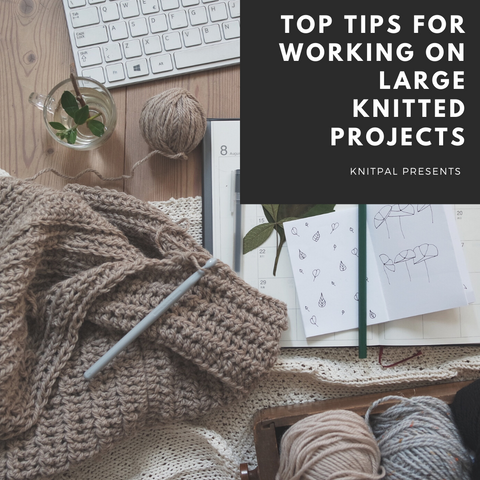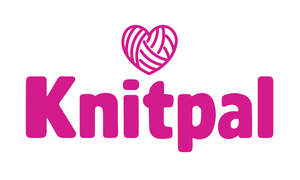
Top Tips for Working on Large Knitted Projects
Whether you decide to make a blanket like the Stadium Blanket or a shawl, knitting or crocheting large projects can be cumbersome at times. That’s why we’ve compiled this list of tips for when you’re knitting or crocheting large projects.

Managing your time
Probably the most important part of working on a large project — especially if it’s for a special occasion or a gift — is managing your time and working to a deadline. If you know a deadline is looming, your knitting or crochet — that usually lessens anxiety and stress — can definitely cause it!
However, it is easier to manage your time than you think.
- First, be honest about the time that you have available before the event and what you’ll be able to make at that time. For example, if you only have a week, you’ll probably go for a smaller gift or use very chunky or bulky yarn. If you have a few months, however, you can opt for a larger gift, even one that uses lace yarn.
- Next, either get a knitting or crochet journal or a notebook (even spreadsheet) where you can keep track of where you are in your project, what you still need to do and how much time you still need to finish.
- Break the project into smaller pieces as well to make it easier to work on and complete. For example, if you’re making an afghan, divide the number of rows by the days or weeks that you have available to you. You may see that you only need to do 5 or 10 rows a day. Focusing on this smaller amount of work that you need to get done is a lot easier and less stressful than thinking about the entire project all the time.
- The journal or spreadsheet can even be used to schedule times when you can work on your project. This may include the time you use to watch series, watch the game or listen to podcasts or audiobooks. It’s important during this time to prioritize your knitting and crochet time as well. You may also be able to work on the project while waiting for your children or during your lunch break.
- Keep either a daily or weekly log (depending on how much time you have) of what you have accomplished so far and how much you still need to do. When you get disheartened about the amount of work still needed, seeing how far you’ve already come can pick you up immediately!
Use a lap desk or tray to hold the weight
While it’s very nice to work on a blanket or afghan during the winter months as it keeps your lap so nice and warm, working on one during summer is another matter altogether.
An easy way to not only lift the project off your legs when it’s too warm (or getting a bit heavy) is to use a lap desk or a butler’s lap tray.
Lap desks are usually used with laptops, but serve just a great a purpose when you need to keep the project off your lap. You can get one at a local office supply store or online, for instance this one from Amazon.
You can also look for small businesses that give a personal touch to their products, for example the Wavy Table from Deskstand.
The butler’s tray (also called a bed tray) looks much like a lap desk and will work in much the same fashion.
This also works fabulous when you have a furry friend who likes lounging on the project as they can lie on the desk or tray and not add to the heat of the afghan.
The same can be done when you are working on a large or chunky shawl or poncho.
Make sure you have enough yarn when you start the project
Because there can be differences in color between different yarn dye lots, you need to rather buy enough yarn for your project before you start. Color differences are not just there when you use hand-dyed yarn, but can also occur in manufactured, factory dyed yarns.
Most hand-dyed yarns have visible color differences between dye lots, although this is not the case with KnitPal’s Pantone color-matched yarns — read more about what makes KnitPal yarn so special here.
It’s not just color changes that can spoil the look of your finished project, however. Because large projects can take significant time to finish, you may not be able to get the same colorway or yarn at all when you find out you don’t have enough yarn to finish a blanket or shawl.
As Stephanie Pearl-McPhee says: “I will always buy extra yarn. I will not try to tempt fate”.
Rather use circular knitting needles — and remember your point protectors
There are few things to a knitter that’s worse than taking knitting out of a project bag — or taking it from under the cat — and finding that stitches have slipped off the needles. It's definitely up there with felting a newly-knit project that ended up in a warm wash by accident!
That’s why you need to use point or tip protectors when you’re not working on your project. When working on a large project or one which requires quite a number of active stitches on the needles, you can also rather use circular needles than straight ones.
If you do use circular needles, you can easily slide your knitting to the center of the cable when you stop knitting. By also adding tip protectors to your circulars, you can then be sure that the stitches won’t find a way to escape off of the needles.
Use a row counter to keep track of where you are
Large projects usually have a lot of rows and a number of stitches to keep track of. To make keeping track of both rows and stitches easier, you can use a row counter.
Row counters also make it a lot easier to keep track of where you are in a pattern if you’re working on more than one project at a time or are working on your team spirit project while the game is on!
There are a wide variety of analogue and digital counters to choose from. These small ones that fit around your finger is perfect for large or very fiddly projects as the button to count the row or stitch is very easy to press. You can also get different colors for different projects. They are also perfect for both knitting and crochet.
These ones from Clover are also popular, as is the relatively new kid on the block — the jewelry-like ring row counter.
Know when the project gets too large for working on in (most) public spaces
Unless you’re working on an almost-completed large project in a place where you can really spread out your work, it’s best not to take your large project with you as your shopping or “standing in a queue” project.
This is especially true of almost-completed large shawls and afghans or blankets that are made in one piece.
Of course, if you’re making a granny square project or another large project that is made up of smaller squares or other shapes, it is a lot easier to then take with you.
Tip: Pack enough yarn to make a few shapes while you’re waiting in the doctor’s office or someplace similar and you’ll get a lot done without getting tangled in your own project.
As you can imagine, arm-knitting projects are also a no-no if you want to knit while waiting in a queue!
When you do want to take your knitting with you when you go shopping (and, let’s be honest, who doesn’t?), why not try one of the smaller KnitPal projects like this Go MI Team hat, 3-in-1 cowl or Pom Pom Striped Scarf Kit?

